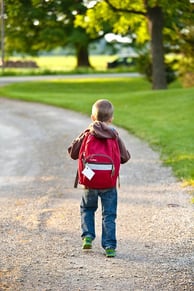
In the beautiful red rock canyon setting of Sedona, Arizona, Caroline Diehl works tirelessly in a cold shed every morning before sunrise filling backpacks with food staples to distribute to hungry local school children.
Invisible
“These kids sit alongside your children in class,” Diehl says. “They are the “invisible poor” who play and do homework with your children but didn’t have breakfast and won’t have dinner when they get home. They’re hungry every day and for the most part, no one notices. The school lunch is often their only meal.”
Famous for its natural beauty, Sedona is located on the Arizona plateau south of the Grand Canyon. A popular tourist destination and wealthy retirement community, it is the last place one would expect to find hungry school children.
 “When I started this backpack program I thought my kids had just run into a few unfortunate children in their school whose parents were too proud to ask for assistance. However, I discovered over the years that there are hundreds of hungry school children right here in Arizona. In my community, I now know who they are. They are no longer invisible to me. Believe me, it is heartbreaking to discover that the little third-grader playing a wise man in the Christmas pageant is hungry every day and struggles to focus on anything other than that relentless, gnawing feeling.”
“When I started this backpack program I thought my kids had just run into a few unfortunate children in their school whose parents were too proud to ask for assistance. However, I discovered over the years that there are hundreds of hungry school children right here in Arizona. In my community, I now know who they are. They are no longer invisible to me. Believe me, it is heartbreaking to discover that the little third-grader playing a wise man in the Christmas pageant is hungry every day and struggles to focus on anything other than that relentless, gnawing feeling.”
Caroline is the Director of the Global Goals and Humanitarian Service programs at an international baccalaureate world school founded in 1951 that offers an integrated program of rigorous academics, environmental stewardship and community service. The seminal “backpack” program Caroline began five years ago has grown into a full-time humanitarian service initiative where her students collect food donations from the entire Sedona community and redistribute the food in backpacks to hungry children at five different schools in the area.
Hungry School Children
 Hunger, though not the focus of many social service agencies, is a factor in the lives of many children. Food insecurity is defined by the US Department of Agriculture as "multiple indications of disrupted eating patterns and reduced food intake”.
Hunger, though not the focus of many social service agencies, is a factor in the lives of many children. Food insecurity is defined by the US Department of Agriculture as "multiple indications of disrupted eating patterns and reduced food intake”.
“Hunger is not confined to elementary school children,” Diehl says. “Teens will conceal hunger, and, though they overwhelmingly prefer employment, faced with acute food insecurity and no employment prospects, they may resort to criminal behavior. And hunger continues into college. The number of campus food pantries established in response to the number of hungry college students has grown to 400 nationwide,” Diehl says.
SNAP
The Social Work Grand Challenges established by the American Academy of Social Welfare do not directly refer to hunger or food insecurity, but at least one-half of the challenges indirectly relate to the condition. However, existing food assistance programs, despite ongoing shortfalls, may be having more of an impact than we sometimes realize. Today, SNAP (Supplemental Nutrition Assistance Program, often referred to as food stamps) is the most prevalent of the 16 food assistance programs provided by the federal government. Many of these programs provide support to children. For example, school breakfast and lunch programs that serve low-income children on a sliding scale of 185% of the poverty level and under are common across the country.
Falling Through the Crack
“Although the SNAP program has been around since the 1930s,” Diehl says, “the need has expanded beyond the government’s ability to look after everyone, and those that are too proud to ask for help can fall through the crack. In 2000, about 17 million people received the SNAP program, but, during the recession, the numbers soared to about 47 million in response to need and changes in the program that made it more flexible. By 2016, when the waiver of work requirements enacted as part of the American Recovery and Reinvestment Act stimulus program had been reinstated, the numbers had decreased to only 45.5 million; they have never returned to the prerecession numbers.”
 Notice Your Neighbor
Notice Your Neighbor
“In our affluent communities, we presume food is abundant. It rarely occurs to us that our neighbors may be hiding their need because they are embarrassed and don’t want to be seen as outside the community. But, watch the children. You can see it in their eyes. When you do; take action,” Diehl says.

